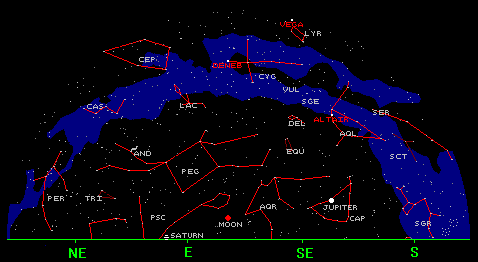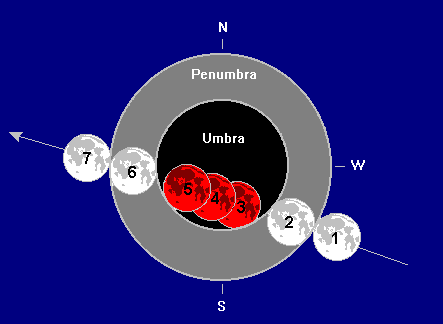THE TOTAL LUNAR ECLIPSE OF SEPTEMBER 16, 1997

Western Europe experienced a total lunar eclipse shortly after moonrise

Observers from Japan, Australia, Asia, Africa and Europe were treated to a spectacular eclipse of the Moon. The eclipse was total. The sight was a head-turner, with a dramatically darkened an reddened full Moon hovering above the horizon. Adding to the scene was bright planet Jupiter 40 degrees to the "right" and Saturn 28 degrees to the "left" of the eclipsed Moon.
Circumstances and area of visibility of the eclipse worldwide
The Moon was high in the dark night sky for observers in Asia. In Japan and Australia the eclipse ended its partial phase after totality around moonset. In Europe and West-Africa the Moon rose partially ecliped or - depending on the east longitude of the location - even totally eclipsed. In the eastern part of Brasil only a penumbral eclipse could be seen during moonrise.

Event GMT 1. Moon enters penumbra 16:11 2. Partial eclipse begins 17:08 3. Total eclipse begins 18:15 4. Greatest eclipse (magnitude 1.19995) 18:47 5. Total eclipse ends 19:18 6. Partial eclipse ends 20:25 7. Moon leaves penumbra 21:22
The first event was the Moon's entry into the penumbra, the pale fringe of the Earth's shadow. No change in light was visible until the Moon's leading edge was more than halfway through it. Around that time a very faint shading at the norteastern part of the Moon became visible. As the eclipse progressed, the penumbra became darker and more obvious.
The next event was when the edge of the moon entered the umbra, the dark inner portion of Earth's shadow. This marked the onset of a partial eclipse. The umbra is much darker than the penumbra and also fairly sharp-edged. The Moon gradually vanished completely. But as it moved deeper and deeper into the dark shadow and the light of the still illuminated part of the Moon faded, a glowing dimly orange, red or brown glow at the immersed part could be be noticed. This was the reddish light of the Sun, which still reached the lunar surface. From those parts of the Moon, a total solar eclipse could be seen, with the sunlight deflected by the Earth's atmosphere creating a reddish-orange rim around the Earth. This soft, reddish-orange glow bathed the lunar landscape.
The total phase lasted for 63 minutes. Binoculars gave a beautiful view!
As totality ended, a new partial eclipse was seen. This time with a gradually 'waxing' Moon. Especially the beginning of the partial phase was a great sight. As bright sunlight returned, the darkened and reddened Moon appeared to wear a brilliant white cap!
The next lunar eclipse will be the penumbral eclipse of March 13, 1998. Only on July 28, 1999 the next partial lunar eclipse will take place. There isn't any total lunar eclipse until January 20-21, 2000 for which Western Europeans and North Americans will have ringside seats.
More information:
 Back to ASTRONET's home page
Back to ASTRONET's home page